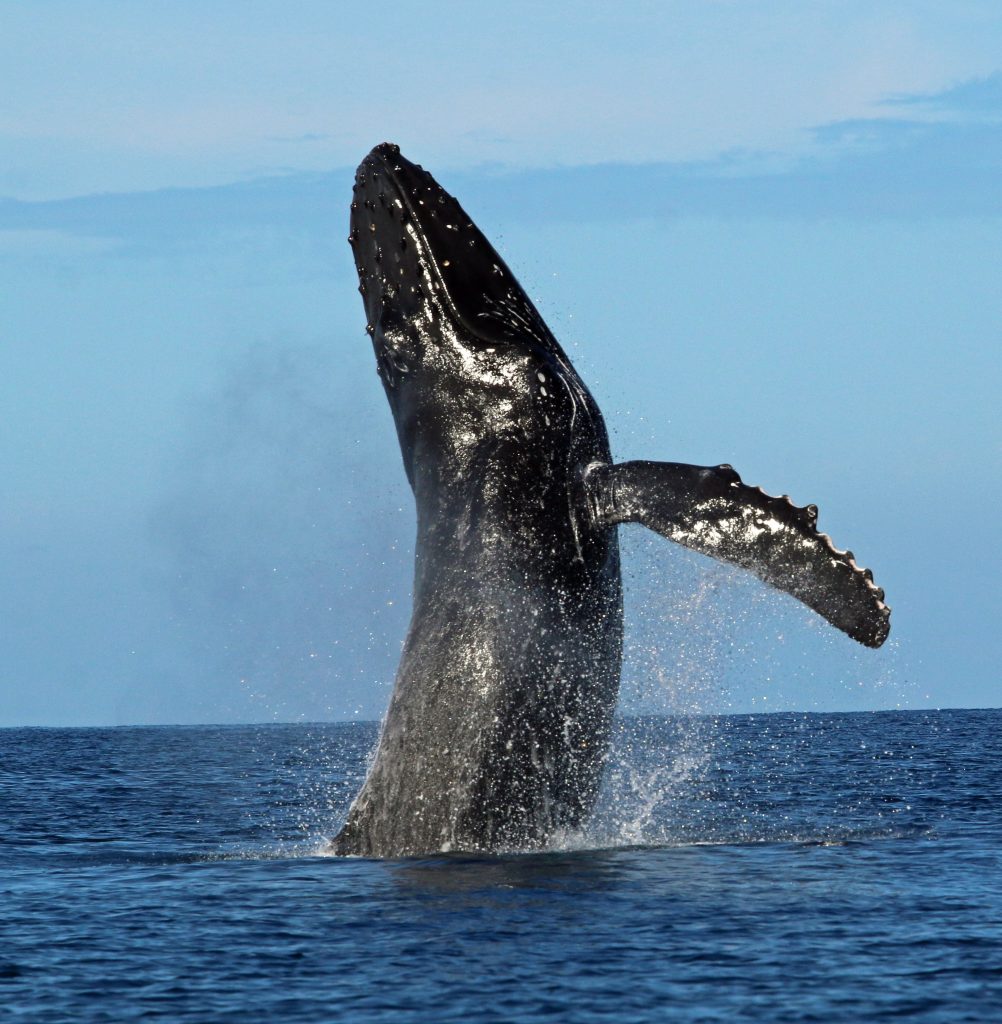The Whales Are Back! Reminder: “Be Whale Aware”
The whales are back, and lucky spectators have been catching glimpses of the majestic creatures in waters off Maui over the past few weeks.

Humpback whale, Oct. 2019 off Maui. PC: Ellen Raimo
Pacific Whale Foundation’s Ocean Spirit spotted its first whale of the season on October 9. The spotting was made in the ʻAuʻau Channel between Maui and Lānaʻi by the PWF during a private Ocean Camp charter.
Earlier this month, captains aboard a tour boat off the coast of Kauaʻi reported that they may have spotted the first humpback whale of the season in Hawaiian waters, breaching about a mile off Keʻe Beach.
The Pacific Whale Foundation estimates that at least 12,000 humpback whales are believed to migrate to Hawaiʻi each winter, with their rate increasing at 7% per year. They travel from their northern summer feeding area that extends from Northern California to the Bering Sea, arriving in Hawaiʻi to mate, give birth and care for their young calves.
Humpback whales are protected by federal and state regulations, which prohibit vessels and other water-users from approaching humpback whales within 100 yards. More information on responsible whalewatching is available through Pacific Whale Foundation’s Be Whale Aware guidelines listed below:
The following are tips were prepared by the Pacific Whale Foundation for vessel operators and ocean-goers alike:
Being Whale Aware:
-
- LOOK OUT, WHEN WHALES ARE ABOUT: From December through May always stay at your helm and post an observer to spot whales while underway.
- SLOW DOWN, WHALES AROUND: From December through May reduce speed to 15 knots or less in ‘whale waters’ (waters 100 fathoms – 600 feet – in depth or less). Reduce speeds to 10 knots or less after dark.
- SEE A BLOW, GO EXTRA SLOW: Reduce your speed to 6 knots or less when within 440 yards of a whale or dolphin group. Avoid abrupt course changes.
- BRAKE FOR WHALES, STOP YOUR PROP: federal and state laws prohibit approaching humpback whales closer than 100 yards.
- 100 YARDS OR LESS = STOP: If your vessel unexpectedly encounters a humpback whale within 100 yards, STOP IMMEDIATELY and allow the whales to pass.
- AVOID APPROACHING whales and dolphins from the front or from directly behind. Always approach and depart from the side rear, moving in a direction parallel to the direction of the whales.
- KEEP CLEAR of the whales’ path. Avoid positioning your vessel within 440 yards of the path of traveling whales.
- BE CAUTIOUS and COURTEOUS: approach areas of known or suspected whale and dolphin activity with extreme caution. Look in all directions before planning your approach or departure.
- LIMIT YOUR VIEWING with whale groups containing calves to 30 minutes. This will minimize the cumulative impact of many vessels and give consideration to other viewers.
- NO MORE THAN THREE: Never more than three vessels of any size or type should stop to watch a whale or dolphin group.
- DO NOT SWIM with or FEED whales.
- If a COLLISION OCCURS, immediately call the National Marine Fisheries Service Marine Mammal Stranding Hotline: 1-888-256-9840. To report a violation of the 100-yard approach rule, or human related disturbance, call NOAA Enforcement: 1-800-853-1964.
Proper Whale Approach
-
-
- Vessels should operate in a direction parallel and to the side rear of the whale’s travel direction, maintaining a minimum distance of 100 yards.
- A vessel’s speed should be six knots or less and never faster than the whale’s speed when engaged in parallel viewing. When disengaging, angle vessel away from the nearest whale, and depart at slow, no-wake speed.
- Do not leap-frog ahead or cut in front of a whale’s path.
-
Need Help?
To report an injured, stranded, or entangled whale, please call the NOAA Marine Mammal Hotline: 1-888-256-9840.
Please report immediately and keep your distance, for your safety. Injured, sick or entangled animals can be unpredictable and dangerous.
*** Supporting information courtesy Pacific Whale Foundation.








